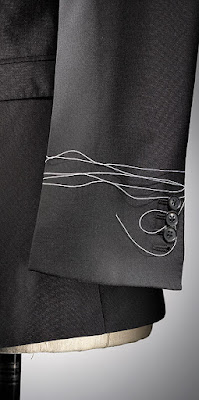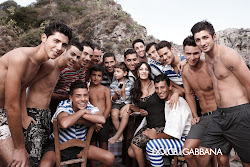Inside Dolce & Gabbana's Secrets of a Damn Good Suit
Here, in the first part of our weeklong celebration of their twentieth anniversary in men's wear, Dolce & Gabbana designers Domenico Dolce and Stefano Gabbana help us pinpoint what every man should look for in a fall suit. (fonte: www.esquire.com/blogs/mens-fashion)
The Fundamentals
"The message we want to convey," says Gabbana, "is universal: To make men feel comfortable, and we do that with the cut of a suit, our attention to detail, and the choice of fabrics. Those are the ingredients that make a suit special." Or, more specifically:
The Cloth: For fall and winter, you'll want cloth that's soft yet sturdy and resilient, like a good beefy flannel. "It's a classic fabric," says Dolce, "and we cannot do without it in our winter collections. It is elegant and versatile, and it allows the suit to always look immaculate." Especially when you opt for a dark and sober shade like charcoal.
The Shoulders: Avoid anything resembling padding and instead insist on a natural shoulder that slopes down gradually and shows off, rather than hides, your natural body shape.
The Lapel: You have options, but for a suit that won't go out of style, go with a peak lapel. "The peak lapel is a big part of Dolce & Gabbana style, and it relates to classic tailoring," explains Gabbana. It also adds definition to your torso and some swagger to your step.
The Silhouette: Keep the jacket tight but not too tight. Dolce describes the ideal fit as one that's "very close to the body so that you can 'feel' the fabric."
One-button wool suit ($2,320) by Dolce & Gabbana.
The Details You See...
The Edges: Hand-stitched edges with the very slight ruffle they create in the cloth (see: the flap pocket on this jacket) are a sign of a superior make of suit.
The Buttonholes: Even if functioning buttonholes — like the hand-sewn ones here — are not the most useful detail, it's reassuring, when talking about serious tailoring, to know that they are there.
...And the Details You Don't
The Interior: The hidden details you'll find on the inside of a jacket are sometimes the most reliable indicators of quality — the idea being that if a tailor skimps on the small stuff, he probably doesn't do too good a job with the big stuff, either. For Dolce, that means focusing on all the things a traditional tailor would focus on — "sartorial features like elegant linings, the piping inside a jacket, and the internal pockets edged with fabric."
The Canvas: Otherwise known as the layer of cloth between the jacket's exterior cloth and its lining, and when a tailor takes the time to sew it into place, it helps the jacket maintain its natural shape over time. To determine whether your jacket has been canvased (or whether it's been finished using an alternative method, fusing, in which a synthetic interlining is heated by a machine until it adheres to the exterior fabric), pinch an inch of the jacket's fabric between the bottom two buttonholes. If you feel only two layers, it's been fused; if you feel three layers, it's been canvased. Or you could just ask.
One-button wool-and-cotton suit ($1,995) by Dolce & Gabbana.
Iscriviti a:
Commenti sul post (Atom)
Best Post You Love
-
Theater: Carolyn Murphy in Dolce & Gabbana su Numéro China nr. 21 settembre 2012
-
Steven Meisel ambientò la campagna per la collezione p/e 2001 in territorio spagnolo, in una piazzetta assolata che faceva da s...
-
La rivista di moda Australiana KURV pubblica un editoriale dai toni molto hot tutto dedicato all'intimo maschile, intitolato 'Ela...
-
Modella, madre, attrice, musa e soprattutto la donna, Monica Bellucci è una forza della natura. Il nuovo volto di Dolce & Gabbana Mak...
-
Dolce & Gabbana su 10 Men Magazine with The Curtain Call by Benjamin Lennox, style by Hector Castro
-
Mercoledi' 22 Febbraio 09,30 SIMONETTA RAVIZZA - VIA SAN LUCA, 3 11,30 PAOLA FRANI - VIA CARLO BOTTA, 8 14,00 GUCCI - PIAZZA OB...
































Nessun commento:
Posta un commento